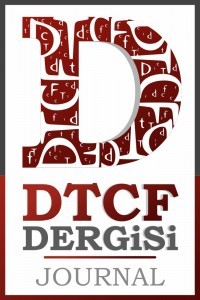ESKİ YAKINDOĞU’DA RAHİP VE RAHİBE TASVİRLERİ
Eski Yakındoğu’da rahip ve rahibe tasvirleri M.Ö. 3000, M.Ö. 3000-2000, M.Ö. 2. bin yıl ve M.Ö. 1. bin yıl olmak üzere makalenin yazarı tarafından bölümlere ayrılmıştır. Yazar, Yakındoğu’da ve dünyanın başka yerlerinde en eski ritüellerin avcılıkla bağlantılı olduğuna dikkat çeker. Bu yüzden rahiplik kurumu da avcılıkla bağlantılıdır. Fakat erkekler ava çıktığında kadınlar geride kalıyor ve kelimenin tam anlamıyla “evin ateşini yanar tutuyorlardı”; bundan dolayı rahibelik kurumu ile ocak arasında sıkça bir bağ vardır. Aşağıdaki makalede söz konusu dönemlere ait pek çok örnek gösterilmektedir. Duvar resimleri, kült kapları ve vazoları, levhalar, adak heykelleri, mühürler, kabartmalı vazolar ve kaya kabartmaları üzerinde yer alan, Eski Yakındoğu’nun rahip ve rahibe tasvirleri tanımlanmaya çalışılmıştır.
Anahtar Kelimeler:
Avcılık, Rahip, Rahibe, Rahip-Kral, Ritüel, Tapınak, Eski Yakındoğu, Tasvir
Depictions of priests and priestesses in the Ancient Near East are shown in the chapters that were titled 3000 B.C., 3000-2000 B.C., and the 2nd millenium B.C., and the 1st millenium B.C. by the author. She has pointed out that the earliest rituals were associated with hunting in the Near East and elsewhere in the world. Therefore priesthood is associated with hunting too. But while the men were out hunting, the women stayed behind and literally “kept the home fires burning”, this is the reason why the association of priestesses with hearth was seemed frequently. Many examples are given in following article for the aforementioned period of time. Depictions of priests and priestesses in the Ancient Near East are defined accordring to wall-paintings, cult vessels and vases, plaques, votive statuary, seals, relief vases and rock reliefs.
Keywords:
Hunting, Priest, Priestess, Priest-King, Ritual, Temple, Ancient Near East, Depiction,
___
- AKURGAL, E., 1961a: Die Kunst der Hethiter, Munich.
- ..................., 1961b: Die Kunst Anatoliens, Berlin.
- AMIET, P., 1980: La Glyptique mésopotamienne archaique, Paris.
- BARNETT, R. D. and Forman, W., 1959: Assyrian palaca reliefs, London and Prague.
- BOEHMER, R. M. and Güterbock, H. G., 1987: Glyptik aus dem Stadtgebiet von Boğazköy-Grabungkampagnen 1931-1939, 1952-1978 (Boğazköy-Hattusa XIV/2), Berlin.
- BRENIQUET, C., 1992: “A propos du vase halaften de la Tombe G2 de Tell Arpachiyah”, Iraq 54, 69- 78.
- CHOLIDIS, N., 1992: Möbel in Ton –Untersuchungen zur archäologischen und religionsgeschichtliche Bedeutung der Terracottamodelle von Tischen, Stühlen und Betten aus dem Alten Orient (Altertumskunda des Vorderen Orients 1), Münster.
- COLLON, D., 1986: Catalogue of the Western Asiatic seals in the Britisch Museum –Clinder seals III. Isin/Larsa and Old Babylonian periods, London.
- ................., 1987: First impressions –Cylinderseals in the Ancient Near East, London; Japanese edition, translated by Y. Kuga, Tokyo, 1996.
- FRANKFORT, H., 1939: Sculpture of the third millenium B.C. from Tell Asmar and Khafäjah (Oriental Institute Publication 44), Chicago.
- GREEN, A. R., 1986: “A note on the Assyrian ‘Goat-Fish’, ‘Fish-Woman’”, Iraq 48, 25-30.
- HERBORDT, S., 1992: Neuassyrische Glyptik des 8.-7. Jh. V. Chr. (State Archives of Assyria Srudies I), Helsinki.
- KULAÇOĞLU, B., 1992: Museum of Anatolian Civilizations –Gods and goddesses, Ankara.
- LAYARD, A. H., 1849: Nineveh and its remains, London.
- MALLOWAN, M. E. L., 1966: Nimrud and its remains, London.
- MATTHEWS, D. M., 1990: Principles of compositions in Near Eastern glyptic of the later second millenium B.C. (Orbits Biblicus et Orientalis, Series Archaeologica 8), Freiburg Schweiz and Göttingen.
- MELLAART, J., 1966:“Excavations at Çatal Hüyük, 1965”, Anatolian Srudies 16, 165-191.
- .................., 1967a: Çatal Hüyük –A Neolithic town in Anatolia, London.
- MOOREY, P. R. S., 1977: “What do we know about the people buried in the Royal Cemetery?”, Expedition 20/1 (Fall).
- MOORTGAT, A., 1967: Die Kunst des Alten Mesopotamien, Cologne.
- MOORTGAT-CORRENS, U., 1988: “Ein Kultbild Ninurtas aus neuassyrischer Zeit”, Archiv für Orientforschung 35, 1117-135.
- MUSCARELLA, O. W., 1974: Ancient art –The Norbert Schimmel Collection, Mainz.
- ÖZGÜÇ, T., 1988:Inandıktepe –An important cult center in the Old Hittite period, Ankara.
- PARROT, A., 1956: Le temple d’Ishtar (Mission Archeologique de Mari 1), Paris.
- ................, 1960: Sumer, Paris, London and New York.
- ................, 1961: Nineveh and Babylon, London.
- ................, 1967: Les temples d’Ishtarat et de Ninni-Zaza (Mission Archeologique de Mari 3), Paris.
- RASHID, S. A., 1984: Musikgeschichte in Bildern II/2. Mesopotamien, Leipzig.
- SPYCKET, A., 1981: La statuaire du Proche-Orient Ancien (Handbuch der Orientalistik VII/1/2 (b/2), Leiden.
- USSISHKIN, D., 1982: The conquest of Lachish beytü’l-mâl Sennacherib, Tel Aviv.
- WATANABE, K., 1993: “Neuassyrische Siegellegenden”, Orient 29, 109- 138.
- Yayın Aralığı: Yılda 2 Sayı
- Başlangıç: 1942
- Yayıncı: Ankara Üniversitesi
Sayıdaki Diğer Makaleler
KAYSERİ-ARGINCIK HAYDAR BEY KÖŞKÜ
MACAR EPİK ŞİİR GELENEĞİNİN KÖKENLERİ
AURORA LEİGH’DE TÜRSEL BİRLEŞİM VE MELEZLİK
DAVID HUME VE IMMANUEL KANT’IN KESİN BİLGİ ANLAYIŞI
ESKİ YAKINDOĞU’DA RAHİP VE RAHİBE TASVİRLERİ
Dominique COLLON, Fatma SEVİNÇ
